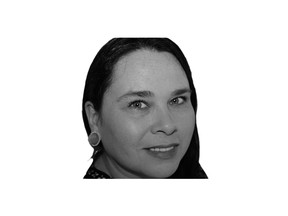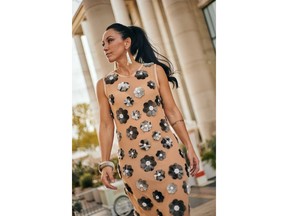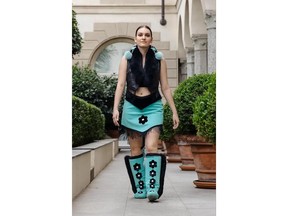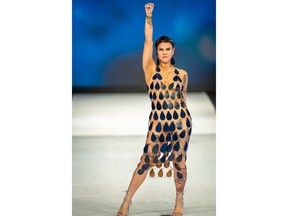
On March 8, International Women’s Day, we celebrate the many women who are breaking down barriers, pursuing their passions, and inspiring young girls to do the same.
Article content
March 8 was International Women’s Day, a day to celebrate the many women who are breaking down barriers, pursuing their passions and inspiring young girls to do the same.
Historically, women have more often than not found themselves working extra hard to prove their worth, capabilities and intelligence in their respective fields.
Understanding the role that intersectionality plays in this issue means acknowledging the different barriers that women face depending on varying factors, including race and class.
Advertisement 2
Article content
Innumerable inspiring stories could be told of strong women from differing backgrounds going after what they want and achieving their goals while simultaneously uplifting other women and raising awareness about critical social issues.
April Allen is one of those stories.

Allen is a contemporary Inuk artist from Rigolet, Nunatsiavut, on the North Coast of Labrador.
Known for her fashion designs and brand, Stitched by April, she began beading and stitching with her mom at a very young age.
Rediscovering her love for beading and sewing
After working as a dental therapist for about 10 years, Allen was diagnosed with an environmental illness and decided it was time to retire.
So, she and her husband decided to move back to Labrador City, where she began picking up the odd job here and there.

“I was a little lost for a few years,” she explained. “It was actually quite a deep depression stage that I went through, having this career and then having to retire out of that field and then having that feeling of what am I gonna do next.”
It was then that she rediscovered her love for beading and sewing.
Advertisement 3
Article content
‘Very healing’
“I had those skills from when I was a little girl, but for years I hadn’t done it until I picked it back up again,” she said. “One of the things that we did together, my mom and I, we volunteered to make face masks for our hometown community in Rigolet and surrounding areas, and that was during the COVID pandemic.
“My mom was a huge support to me and helped me through that,” she emphasized.
It was the volunteering that pushed her to get back into sewing. From there, she picked up beading a bit more, which led to her artwork.
“It was very healing,” she explained. “It was very therapeutic for me to have that sense of, what’s the word I’m looking for? Independence.”
‘Truly inspirational’

Allen then got funding from her government to travel to craft fairs and trade shows. It was on one of those trips in 2022 that she saw a fashion show in Whitehorse.
“One of the designers there was Victoria’s Arctic Fashion,” she recalled.
Seeing her culture on that stage opened her mind to the possibilities of what she could achieve through her own work.
“It was truly inspirational,” she said. “From there, I had a mindset of I can do this, and so I did it. I went home, and I started designing more.”
Advertisement 4
Article content
‘I lost my mom’
She took the initiative and began educating herself more about different patterns, taking online courses, and spending more time learning from the skills already honed by her mom.
“I had my mom to guide me as she was a seamstress all her life,” explained Allen.
Not long after, Allen’s mom passed away.
“I lost my mom almost two years ago now, and in May, it’ll be two years,” she said. “It’s been a little bit tough since I lost her.”
Nevertheless, she persevered.
“I keep moving forward, and I keep doing it for not only myself, but for her as well,” she said.
Stepping into her mother’s shoes
After her mother’s passing, she turned to her aunt for guidance, who, unfortunately, just recently also passed away.
“It’s been a little bit tough, but I strive to inspire the next generation and just create these opportunities for other Inuit within our region and beyond, whether it’s modeling or collaborating with different artists with their work to put into my shows,” she said.
In many ways, Allen has stepped into her mother’s shoes in becoming a role model and inspiration for the younger generation, through teaching virtual lessons across Northern Canada to grades K to 12.
Advertisement 5
Article content
In those teachings, she incorporates traditional materials and talks about culture, alongside lessons about beading.
“It’s really rewarding to be able to share the craft with the kids,” she said. “Just connecting with them and sharing my story and hopefully inspiring them to know that they can follow their dreams and do whatever they put their mind to.”
‘We are now thriving’

Keeping her culture and heritage alive is integral to the work she is doing, explained Allen.
Both her parents went to residential schools. Some of her siblings and grandparents all went to residential schools.
“The whole purpose behind that was to take away our culture and our language,” she stressed.
“We are now thriving.”
‘Many youth who inspire me’
For thousands of years, without Inuit seamstresses, they would not have been able to survive in the North, she explained.
Ensuring that their history, practices, and knowledge are passed down to the next generation is essential so they will always remember and be proud of who they are and where they come from.
Allen noted that, based on her experience teaching young people, an increasing number of youths are enthusiastic about learning and contributing to the preservation of their cultural heritage.
Advertisement 6
Article content
“There are so many youth who inspire me,” she said. “I’m seeing more and more of it all the time.”
‘Huge support system’
Going to the Vancouver Indigenous Fashion Week in 2023 was the first time Allen was seen on a larger scale.
“I had New York Fashion Week reach out to me from my show in Vancouver,” she said. “It’s being able to be submerged into these larger areas and be seen that creates all these opportunities to grow as a business, as an individual.
“But none of it would have been possible without the huge support system that I have.”
Her family, friends, sponsorships, and community as a whole have made it all possible, she said.
From booking travel to modeling the clothes at events, everyone chips in.
“Taking things off my plate allows me more time to work on my designs and produce my designs — they’re such a huge support system,” she said.
New York, Paris, and Milan fashion weeks
Traveling can be costly, and after attending New York Fashion Week, Allen continued on to Paris and Milan fashion weeks last fall.
From the first moment she witnessed her designs being walked down the runway to the most recent, Allen said each and every time she is filled with pride.
Advertisement 7
Article content
“It just brings me such pride watching them walk out on the stage and knowing that they are proud walking out there, sharing their culture,” she said.
The water dress

One particular dress she designed, the water dress, was created with blue leather cut-out pieces to resemble raindrops and was connected with chain. The purpose of the design is to raise awareness of the concerns surrounding clean drinking water.
“It’s a call to action to raise awareness on that issue,” she explained. “In the North, where access to clean drinking water is not always available.
“I’m hoping to someday be able to auction the dress and donate the proceeds towards clean drinking water initiatives in the North.”
‘What art is all about’
There’s so much work that goes into creating these designs, she added. After putting so much love and thought into them, you’re left feeling immense pride over the finished product.
When asked if most of her work is used to make important statements on social and cultural issues, she responded by saying, “That’s what art is all about, expression.”
“To be able to do something meaningful with these expressions and share it with the world and hopefully bring a lot more awareness to it. It’s truly meaningful.”
Anasophie Vallée is a Local Journalism Initiative reporter covering Indigenous and rural issues.
Article content




